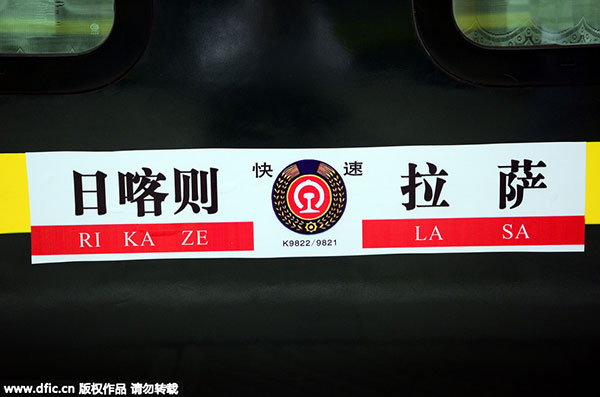 |
|
A passenger train for Lhasa-Xigaze railway is seen at the Lhasa Railway Station in Lhasa, Aug 15, 2014. [Photo/IC] |
Kalzang Tsetan's family business has been benefiting from the opening of the Lhasa-Xigaze railway.
"We've longed for the railway. The materials we used to produce sweet garlic are all imported from Chengdu. Road transport is very expensive. The cost has reduced greatly because of the railway," said the 27-year-old, whose family runs a garlic industry in Gyangze county, a Xigaze prefecture-level city in the southwest of the Tibet autonomous region.
The company produced 2.4 billion kilograms of garlic products last year. In March the company transported about 12,500 kg of sweet garlic products by train from Xigaze to Lhasa at a cost of about 20,000 yuan ($3,222). It was the first time the company adopted rail transportation. By road, 12.5 tons of garlic products cost about 30,000 yuan.
"More importantly, train is much safer than trucks. If an accident happens, we would suffer heavy losses," he said.
It will be the first anniversary of the opening of the Lhasa-Xigaze railway on Sunday. As the railway linking the two largest cities in the Tibet autonomous region, also the second railway in Tibet, the Lhasa-Xigaze railway has not only increased locals’ quality of life but also boosted tourism.
Benefit local's life
The 251-kilometer high-elevation railway cut travel time between Lhasa, capital of Tibet, and Xigaze, the second largest city in the region, from five hours by bus to about three.
The first passenger train left Lhasa for Xigaze on Aug 16 last year. The fare ranges from 40.5 to 175.5 yuan depending on comfort.
The line, which began construction in January 2011, has 14 stations and a maximum train speed of 120 km per hour. It is capable of transporting more than 8.3 million metric tons of cargo each year.
Until June 30 the railway had transported 578,000 passengers.
Since the railway opened, Chungdak Tsering has taken the train more than 10 times between Xigaze and Lhasa.
"It is much more convenient now and only takes three hours. In the past, it took five hours by bus, often longer because of traffic jams and the speed limit, and train is safer. I can either buy tickets online or at the station," the 29-year-old said, adding that this time, he went to the station a day before the trip and bought tickets in five minutes.
Chungdak's trip to Lhasa was to close a deal on a house loan. He is a government employee in Xigaze and bought an apartment in Lhasa.
"Lhasa is a better planned city with a friendly environment, more parks and other resident friendly civil constructions," he said, adding that the railway makes the commute more convenient.
Chungdak is the youngest son in his family. Born and raised in Xigaze, he went to school outside Tibet since middle school at 13, and finished middle school, high school and university there. He returned to Xigaze in 2011.
Compared with the old days when he traveled between home and schools, he has found transportation much more convenient now.
Related Stories